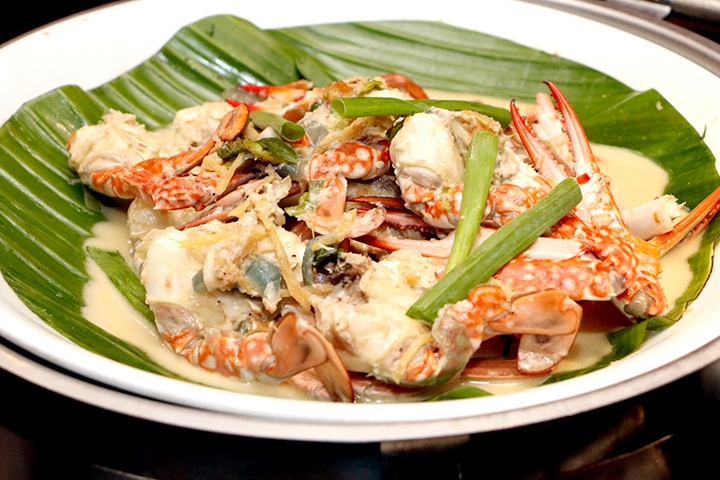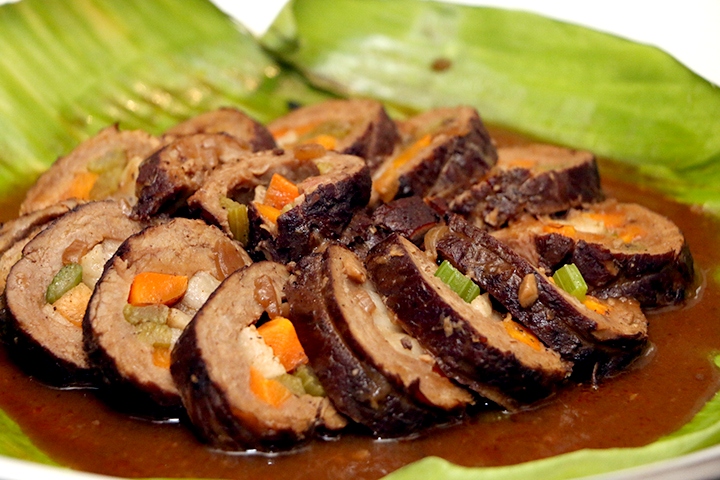
GINATA-ANG Alimasag

Kare Kare
WHEN we speak about Philippine history, we speak about our heroes: their names, important milestones, places, sacrifices, triumphs and misfortunes.
And too often, we forget that food and foodways are also parts of our history, and by that we mean the network of behaviors, traditions and beliefs about food.
By looking back into the lives of our heroes, including the food they ate, we explore how our food is intertwined with our days past and present, and how food holds for us symbolic and
historical meanings. Food maintains the continuity of traditions and history.
And this is what Marco Polo Plaza Cebu has consistently been doing over the years. Ongoing until June 20 is “Independencia: A Tribute to Our National Heroes.”
The culinary festival held in time for the Philippines 117th Independence Day celebration yesterday pays tribute to food and foodways of our heroes, and provides an ethnographic method and description of the Philippine revolutionary life.
As an example, our geography, and the underlying circumstances during the Revolution defined our food which has also influenced the way society was constructed and how eating was a nutritional requirement for bodies engaged in wars at that time.
“During the Revolution, people were always on the go; there were no permanent places to stay for fear of the Spanish authorities,” says hotel consultant Jessica Avila.
So while on the run, the revolutionaries still had to catch crabs and fishes in the rivers (like they used to catch fish in Pasig River as mentioned in Chapter 23 of the “Noli Me Tangere”) but had them fermented as well so that they can readily transport it to the battlefield.
Or made tapas (thinly sliced sun dried beef meat from butchered livestock) as to-go food.
These staple food sustained our freedom fighters during those difficult times. So what did our heroes eat? Well, Dr. Jose Rizal’s favorite tinolang manok na may sili figured well in his magnum opus “Noli Me Tangere” when the main character Crisostomo Ibarra served the bony portions of the soup to the Dominican friars out of condescension, a literary parallelism of Rizal’s antagonistic attitude towards Spanish church officials.
So that must be his favorite food. His dessert was minatamis na santol (sweetened santol) made from boiling santol slices soaked for 3 days in water used to wash rice. As it is being removed from the water, the syrup made from brown sugar is poured and mixed. This is best eaten while still warm, the way our grandmother preferred.

MORCON
Andres Bonifacio who came from a poor family had a very simple fare: inihaw na manok sa saha ng saging (roasted native chicken in banana trunk) and stuffed with tamarind leaves.
The banana trunk’s purpose is to trap the natural juice of the chicken. For this food festival, Ms. Avila’s version was wrapping the roasted chicken in banana leaves. And it was perfect.
Food historians believe that the death of Andres Bonifacio was also the demise of indigenous cooking, at least, in the milieu of Philippine revolution because it heralded the entry of the illustrados and their bourgeoisie cooking which were showcased in special occasions like the Malolos Congress. The cooking was already a hybrid of indigenous, Chinese and European cuisine.
Coming from a wealthy family, Marcelo H. del Pilar’s (known as Plaridel), comfort food was pocherong manok, a Filipinized version of the Spanish soup “cocido” (beef chunks stewed with saba bananas in tomato sauce).
The influence doesn’t come as a surprise because the propagandist was an illustrado who fled to Spain in 1888 to escape persecution until he died of tuberculosis in Barcelona in 1896. The dish has potatoes, chorizo bilbao, cabbage, leeks, garbanzos and bananas.
On Emilio Aguinaldo’s birthday when the revolutionaries retreated to the mountains of Luzon, it was said that Gregorio del Pilar’s group celebrated it with a feast under a tree.
They had arroz Valenciana, umalagang manok na ninamnan ng sarsang strawberry (chicken slathered with strawberry sauce), roasted pig, afritada and fruits in season. One of the youngest revolutionary heroes (a general at 22 years old), history tells us that del Pilar used to sell kakanins (his mother made from home) in his hometown Bulacan when he was a young boy, and where the kakanins are famous.
By looking (and partaking) at the food our heroes ate, we can also construct the economic and political structure of the times.
For instance, the menu, sequence and wine served during Malolos Congress was in French and done in typical Mediterranean style.
To the illustrados, the banquet was a symbol of zenith of Philippine cultural readiness (French cooking was the best at that time, so Filipinos were looking West) which helped shaped the nation’s destiny and which actively reinforced our own national identity.
Though Manila-centric (a regional narrative-based, heroes-themed food festival is recommended), the current food festival at Marco Polo Plaza Cebu contributes significantly to the popularization
of our history and to the meanings of our food traditions.
The event is worthy of public support because food are not only treated as commodities our heroes had. They’re sacred symbols which hold deeper meanings of our tumultuous,
albeit collective glorious past. (Independencia: A Tribute To Our National Heroes run until June 20 at Café Marco. The festival highlights the food of our heroes on top of its international buffet served lunch and dinner.)

